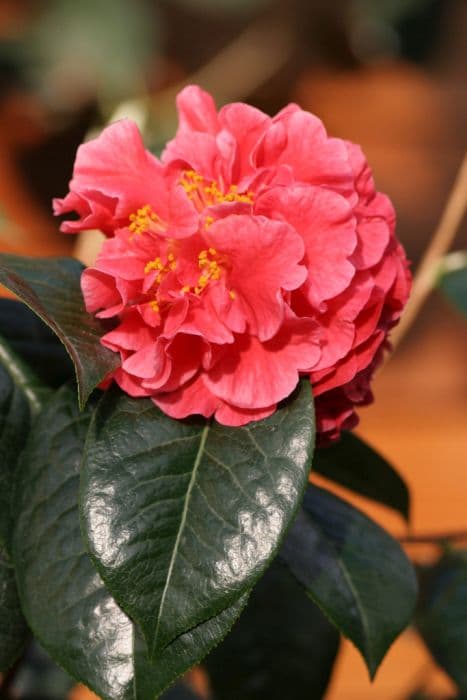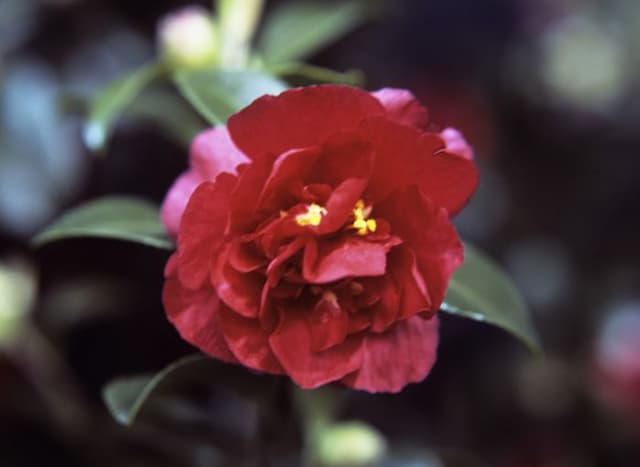Japanese Camellia Camellia japonica 'Desire'

ABOUT
Camellia japonica 'Desire' is a striking ornamental shrub known for its gorgeous blooms and dark, glossy evergreen foliage. The flowers are the most prominent feature, presenting a luxurious display of peony-like blossoms that are delicately ruffled. These blooms exhibit a soft pink hue with shades ranging from pale to a richer tone towards the outer petals, giving it a sense of depth and a romantic appeal. The petals have a velvety texture and might show variations in color with different intensities of pink, often blending with creamy white tones that can appear near the center. The foliage of 'Desire' consists of leathery leaves that maintain their lush green color throughout the year. The leaves have a smooth surface and a slightly serrated edge, which adds a refined texture to the overall appearance of the shrub. This robust plant exudes an aura of elegance and tranquility when in full bloom, making it an excellent addition to gardens seeking a touch of sophistication.
About this plant
 Names
NamesFamily
Theaceae
Synonyms
Japanese Camellia, Camellia, Common Camellia
Common names
Camellia japonica 'Desire'.
 Toxicity
ToxicityTo humans
Camellia japonica, commonly known as Japanese camellia, is not considered toxic to humans. There are no well-documented cases of poisoning or toxicity from ingesting this plant. Consequently, if someone were to consume parts of Japanese camellia, such as leaves or flowers, they are not typically expected to experience symptoms of poisoning.
To pets
Japanese camellia is also not known to be toxic to pets. It is not listed as a poisonous plant for animals like dogs or cats, and ingestion of parts of the plant, including leaves and flowers, is unlikely to result in symptoms of poisoning. As with any non-food plant material, ingestion could potentially cause mild gastrointestinal upset due to the unusual matter in the pet's diet, but significant toxicity is not expected.
 Characteristics
CharacteristicsLife cycle
Perennials
Foliage type
Evergreen
Color of leaves
Green
Flower color
Pink
Height
6-10 feet (1.8-3 meters)
Spread
5-8 feet (1.5-2.4 meters)
Plant type
Shrub
Hardiness zones
7-9
Native area
Japan
Benefits
 General Benefits
General Benefits- Aesthetic Appeal: Camellia japonica 'Desire' provides ornamental value with its attractive pink flowers, enhancing the visual appeal of gardens and landscapes.
- Year-Round Interest: Apart from its bloom time in late winter to early spring, it has glossy evergreen foliage that maintains garden interest throughout the year.
- Shade Tolerance: This camellia is able to grow in partial shade, offering flexibility in garden design and plant placement in areas with varying light conditions.
- Low Maintenance: Once established, it requires minimal care, making it suitable for gardeners seeking plants that don't need frequent attention.
- Drought Resistance: After establishment, Camellia japonica 'Desire' can be quite drought-tolerant, requiring less watering compared to many other ornamental plants.
- Variety of Uses: It's versatile and can be used in various landscape applications such as specimen planting, foundation planting, hedges, or in container gardens.
- Long Blooming Season: The blooming season of Camellia japonica 'Desire' extends for several weeks, providing a long period of floral display.
- Pollinator Attraction: The flowers can attract pollinators like bees, providing a food source for them in the late winter to early spring when few other plants are in bloom.
- Resilience to Pests: It's generally resistant to many common pests, reducing the need for chemical interventions.
- Privacy Screen: With its dense growth habit, it can be used as a privacy screen or to block unsightly views.
- Cultural Significance: Camellias have been grown and appreciated in Asian cultures for centuries, and including them in a garden can add cultural or historical significance.
 Medical Properties
Medical PropertiesThis plant is not used for medical purposes.
 Air-purifying Qualities
Air-purifying QualitiesThis plant is not specifically known for air purifying qualities.
 Other Uses
Other Uses- Camellia japonica 'Desire' petals can be used as a natural dye for fabrics, giving them a delicate pink hue.
- The waxy leaves of Camellia japonica 'Desire' are ideal for creating glossy wreaths and floral decorations, as they retain their shine and shape for extended periods.
- The solid structure of Camellia japonica 'Desire' branches allows them to be used in miniature bonsai cultivation, leading to aesthetically pleasing small trees.
- Camellia japonica 'Desire' can be utilized in the craft of pressing flowers, preserving the beauty of its petals in artwork and handmade paper products.
- The camellia flower is considered a symbol of love and affection in many cultures and thus, Camellia japonica 'Desire' may be gifted as a plant to convey these emotions.
- The vibrant and abundant blooms of Camellia japonica 'Desire' are commonly used in ornate bridal bouquets and wedding decorations due to their romantic associations.
- Camellia japonica 'Desire' flowers serve as unique and delicate cake decorations, especially suitable for events like tea parties or springtime celebrations.
- The robust nature of Camellia japonica 'Desire' leaves makes them suitable for use as natural placeholders or name cards in eco-friendly event settings.
- Flower photographers often leverage the striking appearance of Camellia japonica 'Desire' for visual art, capturing the detail and color of the blooms.
- Camellia japonica 'Desire' can be planted as a privacy hedge in residential gardens, providing both seclusion and aesthetic appeal.
Interesting Facts
 Feng Shui
Feng ShuiThe Japanese Camellia is not used in Feng Shui practice.
 Zodiac Sign Compitability
Zodiac Sign CompitabilityThe Japanese Camellia is not used in astrology practice.
 Plant Symbolism
Plant Symbolism- Love and Affection: Camellias, in general, are often associated with expressing genuine feelings of love and affection, symbolizing the longing of one person for another.
- Admiration: The camellia expresses the sentiment of admiration, often towards someone that is seen as a perfect partner. Given its delicate and beautiful nature, the camellia 'Desire' could be used to convey an even deeper admiration.
- Perfection: With its flawless petals and lush appearance, the camellia is also a symbol of perfection and beauty, indicating a person's desire for these qualities in their life or relationships.
- Longevity and Faithfulness: Since camellias are evergreen and live for many years, they often represent the idea of eternal love or the long-lasting nature of someone's feelings.
- Desire: The specific cultivar name 'Desire' enhances the symbolism of longing and deep yearning, indicating a strong pull towards someone or something that is wanted passionately.
 Water
WaterThe common camellia should be watered to maintain moist but not saturated soil. Generally, it requires watering once a week, but this can vary depending on the climate and soil drainage. During dry spells, watering may be needed more frequently. When watering, apply water slowly at the base of the plant, soaking the soil to a depth of about 8 inches. A good rule of thumb is about 1 gallon of water per watering session for an established camellia in a garden setting, adjusting based on weather conditions.
 Light
LightCamellias prefer bright, indirect sunlight or partial shade. The ideal spot for a common camellia would be in a location where it can receive morning sun and afternoon shade. Too much direct sunlight can lead to leaf scorch, while too little light can cause poor flowering.
 Temperature
TemperatureThe common camellia thrives in temperatures between 60 and 75 degrees Fahrenheit but can tolerate temperatures as low as 0 to 10 degrees Fahrenheit for short periods. The plant prefers consistently cool to moderate temperatures for optimal growth and flowering.
 Pruning
PruningPrune the common camellia to maintain shape and remove dead or weak growth. The best time for pruning is right after the blooms have faded, usually in late winter or early spring. Pruning at this time allows for healthy new growth and does not interfere with the next season's blooms.
 Cleaning
CleaningAs needed
 Soil
SoilJapanese Camellia 'Desire' thrives in well-draining, acidic soil with a pH of 5.5 to 6.5. A mix of two parts peat moss to one part perlite and one part organic compost provides an ideal growing medium.
 Repotting
RepottingJapanese Camellia 'Desire' should be repotted every 2-3 years or when it outgrows its pot, typically in the late winter or early spring before new growth begins.
 Humidity & Misting
Humidity & MistingJapanese Camellia 'Desire' prefers a humidity level of 40-50%. It benefits from a moist environment but not overly wet, which can lead to fungal issues.
 Suitable locations
Suitable locationsIndoor
Place in bright, indirect light and maintain high humidity for Japanese Camellia.
Outdoor
Plant in partial shade, shelter from strong winds, and use acidic, well-draining soil.
Hardiness zone
7-9 USDA
 Life cycle
Life cycleThe life cycle of the Camellia japonica 'Desire', commonly known as the Japanese camellia, begins with seed germination, where the seed requires a period of stratification to break dormancy before it can sprout. Once the seedling emerges, it undergoes vegetative growth, developing a root system and foliage through photosynthesis. As the plant matures, it enters the flowering stage, typically in late winter to spring, producing its showy, large semi-double to peony-form flowers that are pale pink with deeper pink stripes. After pollination, usually by bees, the plant sets fruit in the form of dry capsules that mature by autumn and then release seeds to complete the cycle. The Japanese camellia can also propagate vegetatively through cuttings, which skip the seed stage and sprout roots and shoots directly from the plant material. Over time, with proper care, the shrub can reach a substantial size and live for many years, often several decades, continuing to cycle through seasonal growth and reproduction.
 Propogation
PropogationPropogation time
Late winter - early spring
The most popular method of propagating Camellia japonica 'Desire', commonly known as the Japanese camellia, is through semi-hardwood cuttings. This technique is typically done in late summer after the current year's growth has started to mature and the stems are semi-ripe. Cut a section of the semi-hardwood stem 4 to 6 inches (about 10 to 15 centimeters) long, ensuring it has at least two sets of leaves. The bottom set of leaves should be removed, and the cut end dipped in rooting hormone powder to encourage root growth. Then, plant the cutting in a pot filled with a mix of peat and perlite or a similarly well-draining medium, ensuring at least one node is buried where the leaves were removed. The environment should be kept humid and the medium moist but not soggy until the cutting takes root, which generally takes a few months.









